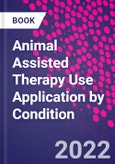Animal Assisted Therapy Use Application by Condition provides the most updated and comprehensive data knowledge on animal-assisted therapy. The book synthesizes historical information, theory, clinical practice, and data from recent clinical studies on animal-assisted therapy for post-traumatic stress disorder (PTSD) and other diseases. Written by international experts drawn from the fields of medicine, clinical psychology and therapy, speech therapy, clinical research, and animal training and welfare, this book employs a hypothesis driven, data rich approach to inform readers on current research and serve as a reference for clinical practice and use of animal-assisted therapy.
This is an important resource for clinicians, researchers, animal trainers and handlers and students who want to understand and utilize animal-assisted therapy in theory and practice.
Please Note: This is an On Demand product, delivery may take up to 11 working days after payment has been received.
Table of Contents
SECTION 1 Introduction
1. Introduction and Synopsis of Chapters Chapter
2. History of AAT and Theories of Mechanism of Action of AAT for PTSD Chapter
SECTION 2 Basic and Clinical Basis for AAT
3. Reduction of State-Anxiety by Petting Animals in a Controlled Laboratory Experiment
4. Incorporating Animal Assisted Therapy into Treatment for PTSD Chapter
SECTION 3 Applications of AAT
5. PTSD in History, Literature and Art Chapter
6. The Use of Service Dogs for Military Veterans with PTSD Chapter
7. Equine Assisted Therapy for Veterans with PTSD Chapter
8. Avian Assisted Therapy for Post-traumatic Stress Disorder Chapter
9. AAT for PTSD in Sexual Trauma Survivors Chapter
10. AAT in Pediatric Patients Chapter
11. AAT for Patients Hospitalized with Heart Failure Chapter
12. AAT in Geriatric Patients
SECTION 4 Animal Trainers' and Patient Perspectives
13. Canine Assisted Therapy for PTSD in War Veterans: Perspective of an Animal Training Organization Chapter
14. Animal Welfare Chapter
15. Canine Assisted Therapy for PTSD: A War Veteran's Perspective Chapter
16. Conclusion and Future Studies and Applications of AAT








